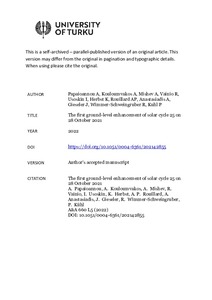The first ground-level enhancement of solar cycle 25 on 28 October 2021
Papaioannou A; Kouloumvakos A; Mishev A; Vainio R; Usoskin I; Herbst K; Rouillard AP; Anastasiadis A; Gieseler J; Wimmer-Schweingruber R; Kuhl P
https://urn.fi/URN:NBN:fi-fe2022081154026
Tiivistelmä
Aims. The first relativistic solar proton event of solar cycle 25 was detected on 28 October 2021 by neutron monitors (NMs) on the ground and particle detectors on board spacecraft in near-Earth space. This is the first ground-level enhancement (GLE) of the current cycle. A detailed reconstruction of the NM response together with the identification of the solar eruption that generated these particles is investigated based on in situ and remote-sensing measurements.
Methods. In situ proton observations from a few MeV to similar to 500 MeV were combined with the detection of a solar flare in soft X-rays, a coronal mass ejection, radio bursts, and extreme ultraviolet (EUV) observations to identify the solar origin of the GLE. Timing analysis was performed, and a relation to the solar sources was outlined.
Results. GLE73 reached a maximum particle rigidity of similar to 2.4 GV and is associated with type III, type II, and type IV radio bursts and an EUV wave. A diversity of time profiles recorded by NMs was observed. This points to the event having an anisotropic nature. The peak flux at E & x2004;>& x2004;10 MeV was only similar to 30 pfu and remained at this level for several days. The release time of >= 1 GV particles was found to be similar to 15:40 UT. GLE73 had a moderately hard rigidity spectrum at very high energies (gamma & x2004;similar to & x2004;5.5). Comparison of GLE73 to previous GLEs with similar solar drivers is performed.
Kokoelmat
- Rinnakkaistallenteet [27094]
